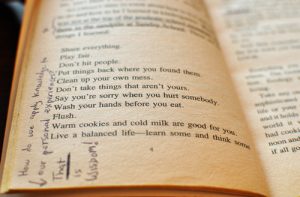Reading
6 Annotating and Taking Notes
 As children, most of us were told never to write in books, but now that you’re an adult student, your instructor will tell you just the opposite. Writing in your texts as you read—annotating them—is a powerful strategy for engaging with a text and entering a discussion with it.
As children, most of us were told never to write in books, but now that you’re an adult student, your instructor will tell you just the opposite. Writing in your texts as you read—annotating them—is a powerful strategy for engaging with a text and entering a discussion with it.
You can jot down questions and ideas as they come to you.
You might underline important sections, circle words you don’t understand, and use your own set of symbols to highlight portions that you feel are important.
Capturing these ideas as they occur to you is important, for they may play a role in not just understanding the text better but also in your college assignments. If you don’t make notes as you go, today’s great observation will likely become tomorrow’s forgotten detail.
Important note: most academic institution bookstores approve of textual annotation and don’t think it decreases a textbook’s value. In other words, you can annotate a textbook and still sell it back to the bookstore later on if you choose to. Note that I say most—if you have questions about your own institution and plan to sell back any textbooks, be sure to ask at the bookstore before you annotate.
If you can’t write on the text itself, you can accomplish almost the same thing by taking notes—either by hand (on paper) or e-notes. You might also choose to use sticky notes to capture your ideas—these can be stuck to specific pages for later recall. For a strategy that helps you take note of what you see as interesting or important points of a text while also responding to those points with your own ideas, see “Dialectic Note-taking” in this text.
Many students use brightly-coloured highlighting pens to mark up texts. These are better than nothing, but in truth, they’re not much help. Using them creates big swaths of eye-popping colour in your text, but when you later go back to them, you may not remember why they were highlighted. Writing in the text with a simple pen or pencil is always preferable.
What about e-books? Most of them have on-board tools for note-taking as well as providing dictionary and even encyclopedia access.
Many students also like to keep a reading journal. A good way to use these is to write a quick summary of your reading immediately after you’ve finished. Capture the reading’s main points and discuss any questions you had or any ideas that were raised. Include the author and title, and write out an MLA citation for the source (see the appendix, Creating a Works Cited Page).
Exercise: Check Your Understanding of Annotation
Print a hard copy of the CBC News article, “New Westminster offers $4M worth of free land for affordable housing.” If you aren’t able to print a hard copy, carry out the following instructions using a piece of paper and a pen or pencil.
- Pre-read the article to gather some first impression ideas. Then read the article completely, annotating as you go.
- Underline what you believe to be the topic or thesis statement in the article. (The thesis statement is one or two sentences that summarizes the article’s main point and tells what it’s about. The thesis statement can occur anywhere in the article—even near the end.)
- As you read, underline points that you find especially interesting. Make notes in the margins as ideas occur to you.
- Write question marks in the margin where questions occur to you, and make written margin notes about them, too.
- Circle all words you don’t understand. Then look them up! (Dictionary.com is a good online dictionary and even pronounces words so you’ll know how they sound.)
- When you’re finished, write a quick summary—several sentences or a short paragraph—that captures the article’s main points.
Text Attributions
- This chapter was adapted from “Annotate and Take Notes” in The Word on College Reading and Writing by Carol Burnell, Jaime Wood, Monique Babin, Susan Pesznecker, and Nicole Rosevear, which is licensed under a CC BY-NC 4.0 Licence. Adapted by Allison Kilgannon.
Media Attributions
- Words of Wisdom by AnneCN is licensed under a CC BY 2.0 Licence.

